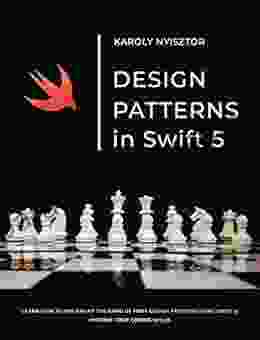Mastering Object-Oriented Design: A Comprehensive Guide to Design Patterns in Swift

Are you ready to take your Swift development skills to the next level? Delve into the captivating world of design patterns and unlock the secrets to building elegant, maintainable, and extensible code.
4.3 out of 5
| Language | : | English |
| File size | : | 1633 KB |
| Text-to-Speech | : | Enabled |
| Screen Reader | : | Supported |
| Enhanced typesetting | : | Enabled |
| Print length | : | 277 pages |
| Lending | : | Enabled |
This comprehensive guide will take you on a journey through the fundamental design patterns that every Swift developer should know. Discover the power of creational patterns to instantiate objects with ease, embrace structural patterns to compose objects effectively, and master behavioral patterns to orchestrate object interactions.
Unveiling the Essential Principles of Object-Oriented Design
Before we dive into the intricacies of design patterns, let's lay a solid foundation with the underlying principles of object-oriented design.
Encapsulation: Concealing Complexity
Encapsulation empowers you to keep the internal workings of your objects private, shielding them from external interference. This promotes modularity and reduces coupling, making your code more robust and easier to maintain.
Abstraction: Isolating Key Concepts
Abstraction allows you to focus on the essential aspects of your objects, hiding unnecessary details. This promotes code reuse and simplifies the development process.
Inheritance: Extending Functionality
Inheritance enables you to create new classes that inherit properties and behaviors from existing classes. This promotes code reusability and reduces duplication.
Polymorphism: Enabling Flexibility
Polymorphism allows objects of different classes to respond to the same message in different ways. This enhances code flexibility and makes it easier to adapt to evolving requirements.
Exploring the Realm of Creational Design Patterns
Creational design patterns provide a blueprint for creating objects without exposing the intricacies of the instantiation process.
Singleton: Ensuring a Single Instance
The Singleton pattern guarantees that only one instance of a class exists within the application. This is useful for managing global resources or maintaining application-wide state.
Factory Method: Abstracting Object Creation
The Factory Method pattern allows you to create objects without specifying the exact class of the object that will be created. This promotes flexibility and makes it easier to extend the application with new types.
Builder: Constructing Objects Step by Step
The Builder pattern enables you to create complex objects by separating the construction process into multiple steps. This improves code readability and makes it easier to customize object creation.
Delving into Structural Design Patterns
Structural design patterns provide mechanisms for organizing and composing objects to achieve desired functionality.
Decorator: Enhancing Objects Dynamically
The Decorator pattern allows you to add functionality to an object without modifying the original class. This provides a flexible way to extend the behavior of existing objects.
Adapter: Making Incompatible Objects Work Together
The Adapter pattern enables objects with incompatible interfaces to work together. This facilitates the integration of legacy code or third-party components.
Bridge: Decoupling Abstraction from Implementation
The Bridge pattern separates the abstraction of an object from its implementation. This allows you to vary the implementation without affecting the abstraction.
Harnessing the Power of Behavioral Design Patterns
Behavioral design patterns provide mechanisms for controlling and coordinating the interaction between objects.
Strategy: Encapsulating Algorithms
The Strategy pattern allows you to implement different algorithms for a specific task and encapsulate them into separate classes. This promotes code reusability and makes it easier to switch between algorithms.
Observer: Notifying Objects of Changes
The Observer pattern provides a mechanism for objects to subscribe to events and be notified when those events occur. This enables loose coupling between objects and promotes flexibility.
Command: Encapsulating Actions
The Command pattern encapsulates an action into an object. This allows you to invoke actions dynamically and defer their execution.
Implementing Design Patterns in Swift
Swift provides a rich set of features that facilitate the implementation of design patterns. From protocols and closures to generics and optionals, the language offers powerful tools for expressing design patterns in a concise and elegant manner.
Leveraging Protocols for Abstraction
Protocols define contracts that classes and structs must adhere to. This enables you to define abstract interfaces and decouple the implementation from the interface.
Harnessing Closures for Strategy and Observer
Closures provide a lightweight way to encapsulate behavior and pass it as a parameter to other functions. This makes them ideal for implementing the Strategy and Observer patterns.
Utilizing Generics for Flexibility
Generics allow you to create code that works with different types without sacrificing type safety. This enables you to implement generic design patterns that can be reused across multiple types.
Embarking on the journey of design patterns in Swift will empower you with the knowledge and skills to build software that is not only functional but also elegant, maintainable, and extensible.
From creational patterns to structural patterns to behavioral patterns, this comprehensive guide has equipped you with a deep understanding of these fundamental design concepts. Armed with this knowledge, you are now ready to conquer the world of object-oriented programming in Swift.
Remember, mastering design patterns is an ongoing journey. Embrace the challenges, explore new patterns, and continually seek to refine your craft. With dedication and practice, you will become a true master of object-oriented design.
4.3 out of 5
| Language | : | English |
| File size | : | 1633 KB |
| Text-to-Speech | : | Enabled |
| Screen Reader | : | Supported |
| Enhanced typesetting | : | Enabled |
| Print length | : | 277 pages |
| Lending | : | Enabled |
Do you want to contribute by writing guest posts on this blog?
Please contact us and send us a resume of previous articles that you have written.
 Book
Book Novel
Novel Page
Page Chapter
Chapter Text
Text Story
Story Genre
Genre Reader
Reader Library
Library Paperback
Paperback E-book
E-book Magazine
Magazine Newspaper
Newspaper Paragraph
Paragraph Sentence
Sentence Bookmark
Bookmark Shelf
Shelf Glossary
Glossary Bibliography
Bibliography Foreword
Foreword Preface
Preface Synopsis
Synopsis Annotation
Annotation Footnote
Footnote Manuscript
Manuscript Scroll
Scroll Codex
Codex Tome
Tome Bestseller
Bestseller Classics
Classics Library card
Library card Narrative
Narrative Biography
Biography Autobiography
Autobiography Memoir
Memoir Reference
Reference Encyclopedia
Encyclopedia Joel T Levis
Joel T Levis John Graf
John Graf Karoly Nyisztor
Karoly Nyisztor John Cowell
John Cowell Joseph Chilton Pearce
Joseph Chilton Pearce Karen Berger
Karen Berger Leora Bach
Leora Bach Jerome Bruner
Jerome Bruner John L Romano
John L Romano Rosamond Mckitterick
Rosamond Mckitterick Kat Zhang
Kat Zhang Michael J Jung
Michael J Jung Ruthellen Josselson
Ruthellen Josselson Jim Arlow
Jim Arlow Myrtis Smith
Myrtis Smith Peter Hames
Peter Hames Miguel F Anjos
Miguel F Anjos Pamela K Keel
Pamela K Keel Phillip Whitt
Phillip Whitt Joe Nick Patoski
Joe Nick Patoski
Light bulbAdvertise smarter! Our strategic ad space ensures maximum exposure. Reserve your spot today!

 Allan JamesEmbark on a Mesmerizing Odyssey of Fractal Flames: Unveiling Volume Sixteen...
Allan JamesEmbark on a Mesmerizing Odyssey of Fractal Flames: Unveiling Volume Sixteen... Richard AdamsFollow ·2.8k
Richard AdamsFollow ·2.8k Oscar BellFollow ·11.1k
Oscar BellFollow ·11.1k Caleb LongFollow ·2.2k
Caleb LongFollow ·2.2k William FaulknerFollow ·9.9k
William FaulknerFollow ·9.9k Brennan BlairFollow ·16.6k
Brennan BlairFollow ·16.6k John MiltonFollow ·17.2k
John MiltonFollow ·17.2k Michael SimmonsFollow ·16k
Michael SimmonsFollow ·16k Andy HayesFollow ·15.4k
Andy HayesFollow ·15.4k

 Julio Cortázar
Julio CortázarAn Illustrated Encyclopedia Of Live Concerts And...
Immerse yourself in the...

 Edgar Cox
Edgar CoxNon Physically Assaultive Attachment Based Chronic Covert...
What is Covert...

 Robert Reed
Robert ReedThe Baseball of Why: Unraveling the Intricacies of...
Step up to the plate and...

 Aldous Huxley
Aldous HuxleyTacos and Beer: An Atmosphere of Flavorful Delights
In the realm of culinary adventures,...

 Stan Ward
Stan WardUnlock the Secrets of the Aramaic Jesus: Revelations of a...
Journey Back to the Roots of...

 Vincent Mitchell
Vincent MitchellMillionaire Success Strategies: Your Blueprint for...
Unlock the...
4.3 out of 5
| Language | : | English |
| File size | : | 1633 KB |
| Text-to-Speech | : | Enabled |
| Screen Reader | : | Supported |
| Enhanced typesetting | : | Enabled |
| Print length | : | 277 pages |
| Lending | : | Enabled |










